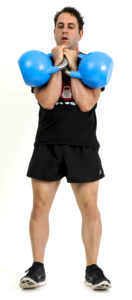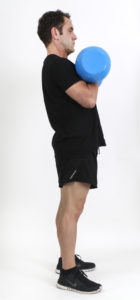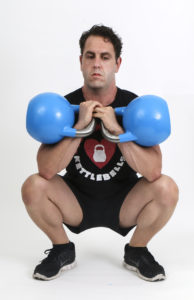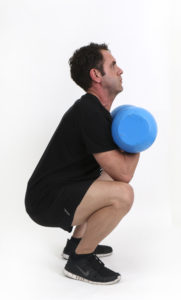This is an awesome lower body movement that will tax your legs and strengthen your core at the same time.
Unlike the barbell front squat, the kettlebell variation is a sneaky beast. Even with low weight kettlebells, people who are used to doing 80kgs plus with the barbell front squat will find two 20 kg kettlebells a nice challenge.
How to do it:
With the kettlebell in the rack position sit back and down in between your hips, with your glutes as low as possible without curving your lower back. Your chest should be held high throughout the whole exercise to create and maintain an arch in your lower back.
Sit momentarily, and then push through your heels to explode back up to standing top position.
Tempo: 2 seconds down, 1 second hold, one second explode upward.
Repeat for desired amount of reps.
Start position for Kettlebell squat
Bottom position for squat
Breathing:
Take a breath in to pressurise your body, squat down and hiss the air out on the way up to help push you through the sticky point of the movement. Everyone will have their own sticky point to contend with, use the irradiation and power breathing techniques to help you overcome yours.
Things to watch for and correct:
Dipping of lower back:
Usually, when your lower back starts curving, causing your glutes to dip under when coming into the bottom position of the squat, it indicates that there are some flexibility issues regarding the glutes and/or hamstring.
To fix the dip, you will need to start box squatting, stretching and mobilising the hamstring, glutes and hips. You can perform squat to stand, x band walks, Cossacks, cat-camels, and alternating superman’s. Try 10 reps of each before you start your workout.
With the box squat, you will need a partner to watch your technique. Progress lower and lower until you can go ‘ass to grass’ (all the way down), without curving the lower back. Eventually, you won’t need a box to go all the way down.
Knees drifting inwards:
To stop knee drift, you will need to strengthen the vastus medialis, the inner muscle that makes up the quadriceps. Try tying a belt around your legs and forcing your knees open to hold the belt up. If the belt drops down, you know that you weren’t keeping your knees spread open during the lift and buckling inwards when coming up.
Single legged squats, wall squats, Bulgarian split squats and lunges will help fix this problem and to strengthen the muscles of the thigh.
A fallacy:
Don’t listen to any baloney about squatting being bad for your knees. Full squats actually strengthen the knee capsule, while doing quarter and half squats won’t due to the tremendous force needed to stop your descent and push you back upright. This is why some people believe squatting is bad for the knees. Don’t be a half rep hero!
Variations:
Double Kettlebell Squat
Overhead Squat
Goblet Squat




